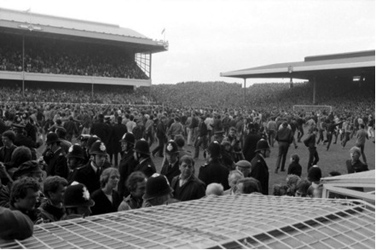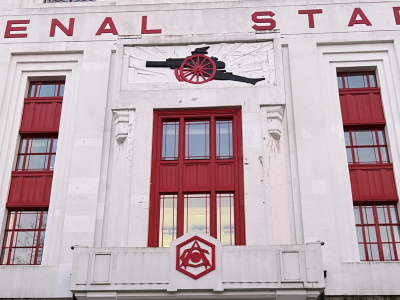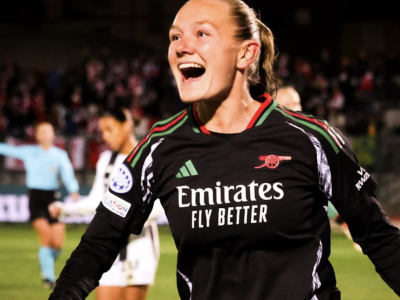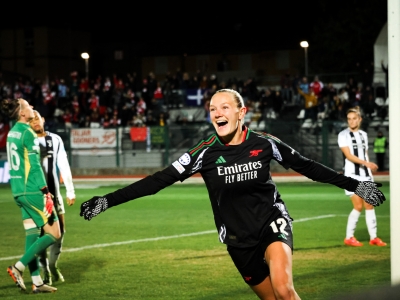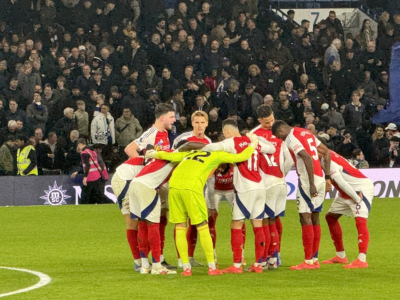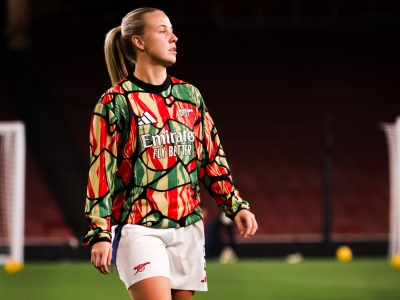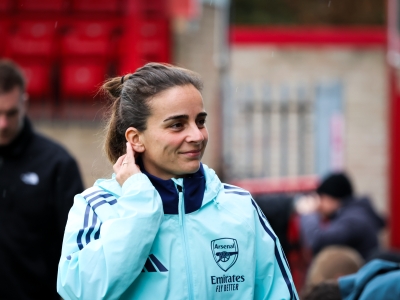Aston Villa’s first visit to Arsenal came in October 1904 with a 1-0 win for the Gunners at the Manor Ground in front of 7500 fans. Arsenal would win the first three home fixtures against Villa – with a 2-1 win in April 1906, followed by a 3-1 win exactly twelve months on. Making his last appearance for Aston Villa in the former would be a player called Herbert Kingaby, who had been involved in one of the earliest employment law disputes in English football regarding the legality of the Football League’s retain and transfer system. Villa signed Kingaby from then Southern League side Clapton Orient for a figure of £300 (then considered a high sum), however turned out to be a flop signing.
Wanting rid of Kingaby but not willing to take a loss, Villa’s asking price was considerably above his market rate, with no takers for his signature. Without appearances, Kingaby’s wages had been stopped though he remained on Villa’s retained list which prevented a move to any other Football League club. Kingaby however moved to then Southern League side Fulham without Villa’s authorization, as the Southern League at the time didn’t recognise the Football League’s registration system. When this scenario changed in 1910, Aston Villa demanded a transfer fee of £350.00 when Kingaby tried to rejoin Orient.
Kingaby brought legal proceedings against Aston Villa two years later for a restraint of trade, in a case funded by the Players’ Union to challenge the ‘retain and transfer’ system. Kingaby’s counsel however screwed up by concentrated on Villa’s allegedly malicious use of the transfer system and made no use of the law on restrictive practices. Kingaby lost his case and the legal fees almost financially ruined the Players’ Union. It would be another half a century before the Players’ Union dared to challenge the transfer system again, when Arsenal’s George Eastham took on his old employers Newcastle United in the high court and won.
Back to 1908 and Aston Villa’s first away win against Arsenal followed in February of that year, where the visitors inflicted a 0-1 defeat on the Gunners at their then home ground in Plumstead. The following season however, in April 1910, Arsenal achieved a 1-0 win over a Villa side eight points clear at the top of the table. That season Villa went on to win their last League title for the next seven decades. Aston Villa’s first visit to Highbury came in January 1920, inflicting a 0-1 defeat on Arsenal with a goal from Clem Stephenson, who went on to become Herbert Chapman’s first signing at Huddersfield and a mainstay of his side which won three straight titles during the 1920s.
A second straight 0-1 defeat followed the following September before Arsenal attained their first win over Villa at Highbury, with goals for Henry Albert White and Reg Boreham. The earliest video footage of an Aston Villa visit to Highbury comes from late February 1926, during Herbert Chapman’s first season, which came in the FA Cup fifth round replay. The first match at Villa Park had been drawn 1-1, with Charlie Buchan on the scoresheet. Back at Highbury four days later, Arsenal secured a 2-0 win with goals from Jimmy Brain and James Paterson in front of 71,446 spectators. The following April, an Arsenal side chasing Huddersfield for the title in second place closed the gap to four points after another 2-0 win over Villa at Highbury, with both goals coming from Jimmy Brain.
Arsenal won their first ever trophy in 1930, by securing the FA Cup in late April. Their final league fixture of the season followed a week later at Highbury, though suffered a 2-4 defeat to Aston Villa with two goals for Jack Lambert for the Gunners while for Aston Villa there were goals for Eric Houghton, George Brown and two for Pongo Waring. Arsenal finished the season in fourteenth place, though the following season won their first League title. In early November, Arsenal were one point ahead of Aston Villa at the top of the table, when the Midlands side visited Highbury. Arsenal picked up a 5-2 win over Villa with goals from Jack Lambert, two for David Jack and two for Cliff Bastin, while Pongo Waring scored twice for Aston Villa.
Arsenal’s defence of the FA Cup started at Highbury in January against Aston Villa. As the game was played in thick fog, Aston Villa’s captain Billy Walker, Arsenal skipper Tom Parker and the referee agreed from the start of the match to turn straight round at half time and play the second half without interval. Arsenal went 0-2 down at the end of the first half however and Herbert Chapman rushed to the touchline and ordered his players to the dressing room for a ten minute rest which upset Villa captain Billy Walker. The trick however worked, as Arsenal pulled two goals back in the second half from Jack Lambert and a wonder goal from David Jack, ending in a 2-2 draw which took the tie back to Villa Park four days later.
Chapman’s act of gamesmanship may well have been up there with Angelo Dundee cutting Muhammad Ali’s glove after Henry Cooper floored the latter, however it didn’t amuse the FA much and as a result ruled that no official of a club should be allowed to walk on the field of play without the permission of the referee. The Gunners however eliminated Villa from the competition with a 3-1 win, with goals for David jack and two for Jack Hulme, in front of an incredible 73,668 fans on what was an afternoon kick off. The following season, Aston Villa visited reigning champions Arsenal on what was another fog bound Highbury afternoon in late October.
Arsenal were three points behind League leaders Everton in fourth place, though just three points separated them from ninth placed Aston Villa. Goals for Arsenal’s David Jack and Villa’s Pongo Waring meant that the points were shared with a 1-1 draw. Arsenal missed out on the League title to Everton by two points in 1931/32, however were in the running again for 1932/33. After an 8-0 win over Blackburn Rovers in Late February, Arsenal held a four point cushion at the top of the table under a two for a win system. The Gunners however hit a run of poor form gaining just one point from a possible eight, with three defeats out of four at home to Liverpool, Wolves and away at Newcastle with just a draw at Leicester for consolation.
When Arsenal met Aston Villa at Highbury on 1st April 1933, the Gunners’ lead had been cut to just one point over Sheffield Wednesday in second place who had a game in hand. Aston Villa also had title hopes of their own, three points behind in third with two games in hand over the Gunners. Arsenal however pulled off a 5-0 win over Villa that afternoon, with goals for Alex James, David Jack, Ray Bowden and two for Jack Lambert, while a Sheffield Wednesday draw to Chelsea gave the Gunners a two point cushion. For Arsenal, the win over Villa started a run of five straight wins and scoring fourteen goals in the process, while title rivals Sheffield Wednesday wobbled with three straight defeats which included a 4-2 win for Arsenal away at Hillsborough on the back of a 0-4 loss for Wednesday away at Huddersfield.
Arsenal secured the title with a 3-1 win away at Chelsea while Aston Villa finished the season as runners up, four points behind Arsenal. Villa’s next trip too Highbury came in March 1934, in the FA Cup Quarter Final. A Peter Dougall goal for Arsenal however wasn’t enough to prevent a 1-2 defeat which eliminated the Gunners from that season’s FA Cup, with Dai Astley and Eric Houghton on target for Villa. One week later however, Villa return to Highbury in the League. Arsenal were going head to head with Huddersfield in the race for title on equal points with Huddersfield leading on goal average by 0.04 of a goal.
In the weeks prior Leicester effected the title race with a 1-0 win over Huddersfield, though also inflicted a 1-4 defeat on Arsenal forty eight hours before the Villa game at Filbert Street. Arsenal however got their season back on track with a 3-2 win over Villa with goals for David Jack, Herbert Roberts and Joe Hulme for Arsenal, while Ronnie Dix and Eric Houghton would be on target for Villa. Arsenal went on to retain the title again at Stamford Bridge after a 2-2 draw. Ahead of Villa’s next visit in early November 1934, Arsenal lost the top spot with a 2-2 draw away at Grimsby. Villa inflicted a 1-2 defeat on Arsenal, with Eric Houghton scoring for Midlands side once again, while a Cliff Bastin penalty would be a consolation for the Gunners.
As a result Arsenal dropped to third and three points behind leaders Sunderland. Arsenal however managed a hat-trick of league titles come May with a 1-0 win away at Middlesbrough. Villa fans today however would recognise that sinking feeling which Villa suffered in 1935/36 season, as the Midlanders hovered one point over the relegation zone by the time of their visit to Highbury in mid-April. The Gunners had left Villa Park with a 7-1 win in the famed encounter when Ted Drake set the record for most goals scored in one game, by bagging all seven goals. Ted’s record however was broken just twelve days later, when Robert Bell scored nine for Tranmere against Oldham in the Third Division South and once again the following April, when Luton’s Joe Payne scored ten in a 12-0 win over Bristol Rovers. Ted’s effort however still remains a top tier record to this very day.
However Villa’s hopes for the 1936/37 season however were raised by the following April with a 4-2 win over fellow strugglers Wolves and losing just one game in the previous six. Arsenal meanwhile, after three straight League titles would be languishing in seven position, already out of contention for the League title and fourteen points behind leaders Sunderland who had already sealed the League title with a 7-2 win away at Birmingham City the week prior. Arsenal however had the FA Cup Final to look forward to the following week against Sheffield United at Wembley. Arsenal rested first teamers Herbert Roberts, Joe Hulme and Ray Bowden ahead of the final, though took a chance on playing Ted Drake who had fitness doubts ahead of the final.
Ted Drake would be on target again for Arsenal, five minutes from time as the Gunners secured a 1-0 win. Drake, who received the match ball signed by the entire Villa team after his seven goal heroics earlier on in the season, actually apologised to the nearest Villa defenders after scoring against them. Aware of the fact that Drake was under pressure to prove his fitness ahead of the final, Villa defender Danny Blair responded by saying: ‘it’s alright son, it was either you or us’. That defeat pushed Villa down to second from bottom with just one game left to play, while the three sides just one point above them – Wolves, West Brom and Everton - all had games in hand.
While modern Arsenal fans might well goad Villa on Sunday with ‘we’ll never play you again’, according to Tom Whittaker in his autobiography the Highbury crowd actually serenaded Villa with the old music hall tune of ‘Dear Old Pals’ as they left the pitch, as the once mighty Villa looked like dropping out of the top flight for the first time in their history. By the time Villa came to play their final fixture however they remained on equal points with Wolves and Everton, meaning that they were still in with a chance of avoiding relegation as they lined up at home against bottom place and already relegated Blackburn Rovers.
A 2-4 defeat for Aston Villa however condemned them to their first ever relegation after being a top flight side since the inception of the Football League forty eight years prior, Arsenal meanwhile on the same day won the FA Cup at Wembley with a 1-0 win over Sheffield United. Some hope for modern day Villa fans might be that Villa returned to the top flight within two years, as the Second tier champions in 1937/38. In the final full football season before the outbreak of the Second World War, Aston Villa visited reigning League Champions at Highbury in late September. Arsenal however had a poor start to 1938/39, winning just two of their first six games, Villa meanwhile had managed three wins out of six, scoring nine goals in the previous two games with a 4-2 win away at Blackpool and a 5-0 win at home to Brentford. The game at Highbury however ended in a 0-0 draw.
Villa’s first visit to Highbury after the Second World War came in January 1947, in what was a poor season for Arsenal who were languishing in thirteenth position in the old First Division behind the now non-League Grimsby Town. A 0-2 defeat at home to Villa furthered Arsenal’s misery and dropping three further places to fifteenth. George Allison, who oversaw two previous League title wins, an FA Cup win and used his media skills to push Arsenal deep into the national consciousness decided at the age of sixty four to quit the Highbury hot seat when Arsenal finished in the bottom half. Allison’s last game in charge would be Arsenal’s final league fixture of the 1946/47 season against Everton at the end of May.
His place was taken by Tom Whittaker who took charge for Arsenal’s final game of the season away to Sheffield United on 6th June, due to a fixture pile up caused by an exceptionally cold winter and the fact that the use of floodlights were yet to be permitted. Whittaker had reversed Arsenal’s fortunes to such an extent that they were enjoying their best ever start to a season at the beginning of 1947/48, winning eight of their first ten games. Arsenal’s form continued with a 1-0 win over Villa in early October with a goal from Ronnie Rooke. Arsenal failed to lose a game until the end of November and took the title the following May with by a seven point margin under a two points for a win system.
Both Arsenal and Villa however had a poor start to the 1948/49 season when the Midlands side visited Highbury in early September. Arsenal however pulled off a 3-1 win with goals for Don Roper and two penalties from Ronnie Rooke. Villa’s first post-war win at Highbury came in late March 1950, inflicting a 1-3 defeat on the Gunners. Arsenal were back challenging for the League title again in 1951/52, when Villa came to Highbury in early January. Arsenal were in third place, three points behind leaders Portsmouth. Two goals for Don Roper gave Arsenal a 2-1 win. Arsenal missed out on the title by four points, finishing in third place, however were challenging again the following season. At the time of Aston Villa’s visit to Highbury five days before Christmas 1952, Arsenal were in fourth position, four points behind leaders Wolves but with two games in hand.

